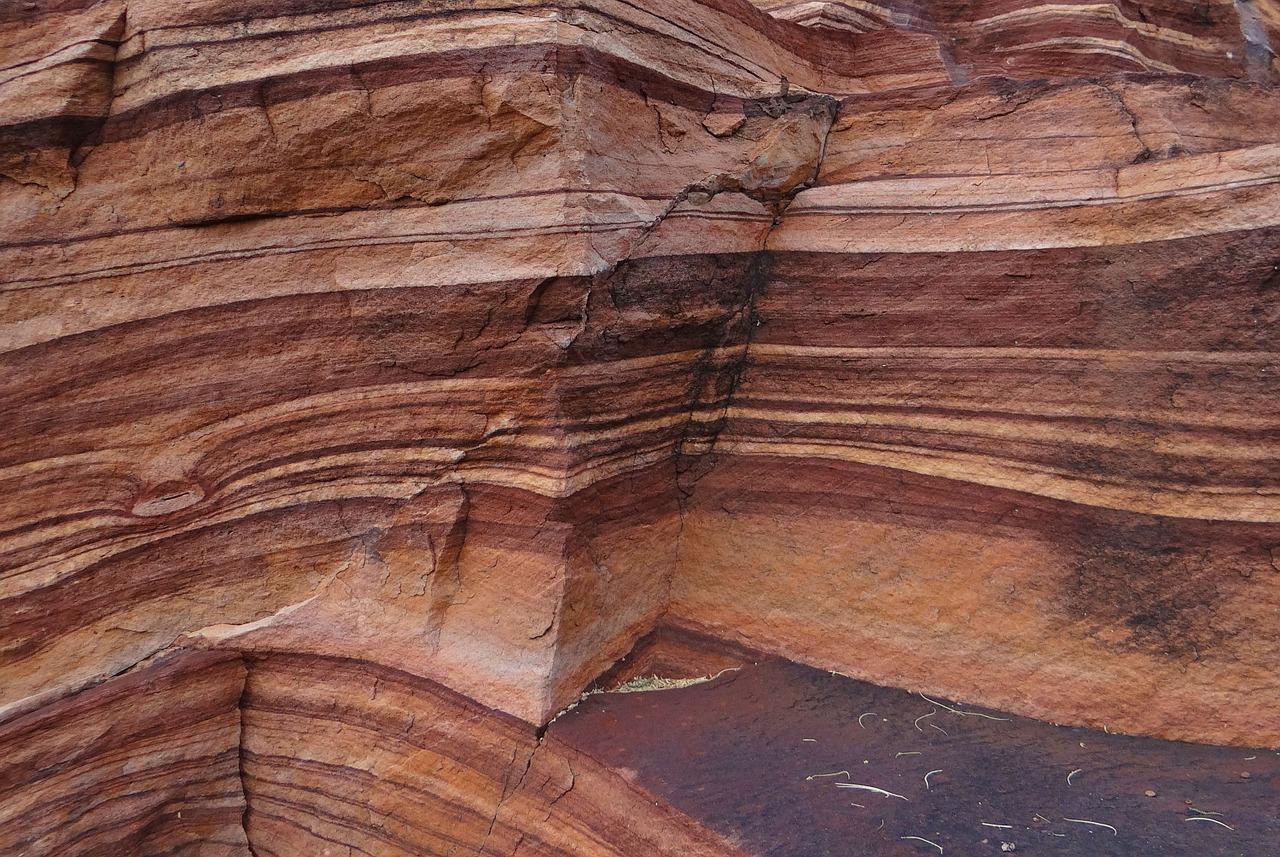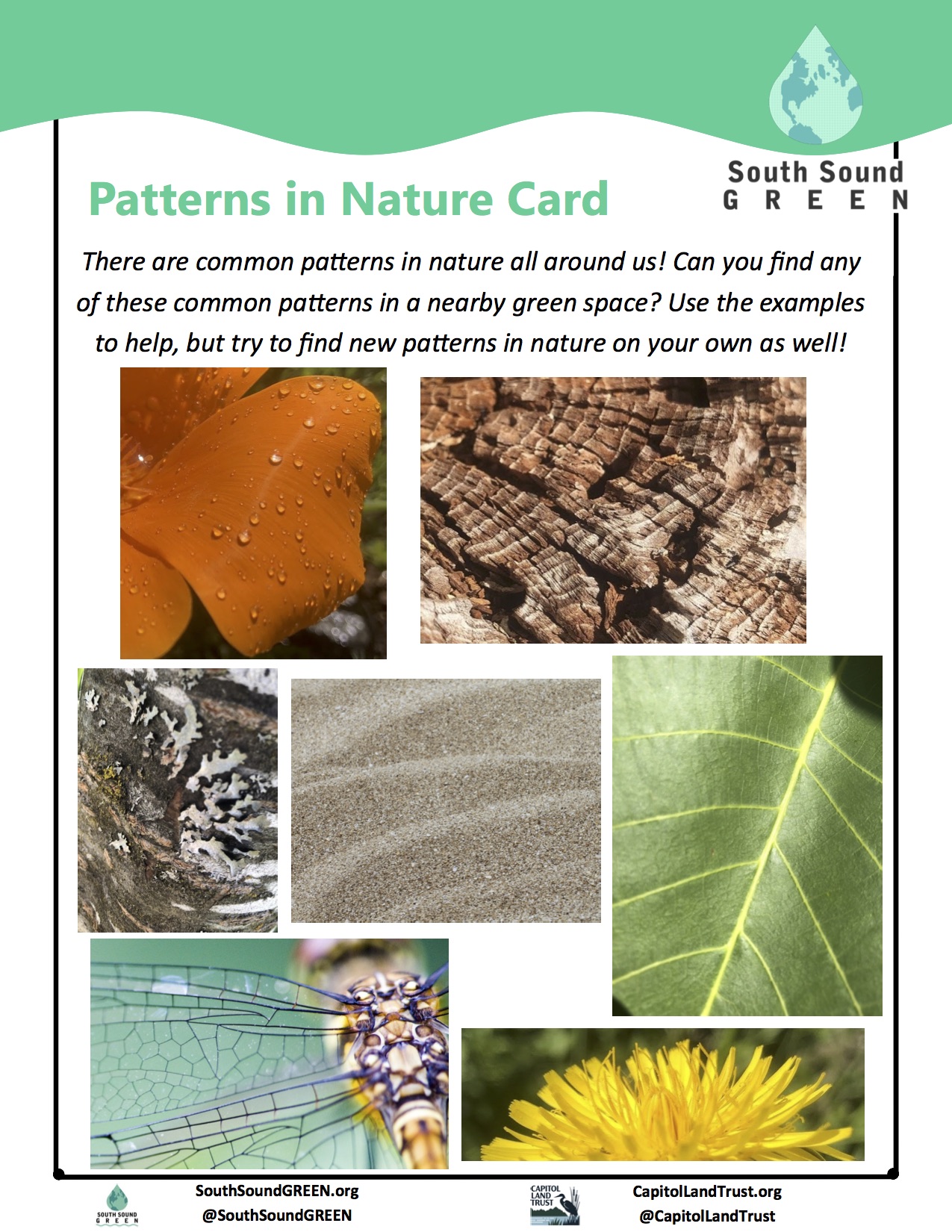Submitted by South Sound GREEN
In the face of COVID-19 and recent stay at home order, parents and guardians may find themselves looking for activities that not only keep students engaged, but also provide information about local environmental science and concerns. In our South Sound GREEN Home Based Science Project series, we will introduce and demonstrate various hands-on and at-home activities for children of all ages to do either indoors or outside!
 This time we’re partnering with Capitol Land Trust to teach you about finding patterns in nature!
This time we’re partnering with Capitol Land Trust to teach you about finding patterns in nature!
Patterns in Nature
Grade Level: K-3rd
Materials
- Patterns card (provided below)
- Outdoor green space (suggestions provided below)
- Magnifying glass (optional)
If you’ve ever walked through a park or forest, you might have noticed a lot of plants with similar leaves, but not quite the same. Or, if you’ve been walking on the beach at low tide, you might have found round, spiral snail shells of different shapes and sizes. These are examples of common patterns in nature – trends that show up in nature across organisms and even different species.
A pattern is a repeated design, and in the natural environment, there are many different patterns and reasons for an organism to take on a certain pattern. One reason could be that a particular pattern is most beneficial for keeping the organism alive. Flowers tend to have colorful and beautiful patterns to attract pollinators, such as bees and hummingbirds. Contrasting color patterns on the other hand, like those found on the poisonous rough-skinned newt, alert potential predators that they are not safe to eat, both keeping the newt and the potential predators alive. A common and fascinating example of patterns in nature is the use of camouflage, or a type of pattern or coloration that makes an organism visually blend in with its surroundings. The best example of this is a chameleon, which blends into its surroundings by becoming the color of its surroundings! Other animals, such as the snowshoe hare, change their fur with the seasons – gray and brown fur in the summer and fall, when they would be hiding behind trees and leaves, and white fur in the winter and spring, when they would be hiding in the snow. The reason for this is to completely hide from predators – you can’t get eaten if you can’t be seen! Patterns can even help organisms distinguish themselves from one another within the same species, just like humans!

Patterns are not just exclusive to plants and animals – non-living things in nature can have patterns too! Rocks, for example, can take on certain patterns depending on how they were formed. In the picture below, this rock has a layered pattern because it was formed by many thin layers of sand and other small rocks falling on top of each other. If you’ve ever been to a beach and looked out at the water, you might also notice that the waves have a certain pattern, with white foamy water at the top of the wave crashing down on the darker sea below. Why do the waves look like this? Recognizing these patterns can tell us a lot about objects and features in nature that we can’t ask for the answers!

If you look close enough, you’ll find that there are a lot of different patterns that are repeated over and over again in nature. Living things, through evolution, have found common ways to grow and survive, developing similar patterns even in opposite parts of the world. In this activity, you’ll be getting outside and finding different patterns on your own!
Procedure
- Find a local green space to conduct the following activity. We recommend one of Capitol Land Trust’s free and public preserves! But any green space will work great.
- Print the following Patterns Card. The Patterns Card shows examples of some common patterns in our local, natural areas. You can also find a link to the Patterns Card here.

- With your card in hand, go explore your green space and try to find as many patterns as you can from the card. You can match patterns based on shape, color, or other features you see. If you have a magnifying glass, you can get really up close to find patterns. You’ll likely be able to find plants and bugs fairly easily, but you’ll need to be quiet and patient if you want to see any animals!
- Are there any patterns you can’t find? You may need to go to a new green space, or wait for a different time of year.
- Make sure you’re not disturbing nature at all while you’re on your patterns hunt!
Vocabulary
- Camouflage: A type of pattern or coloration that makes an organism visually blend in with their surroundings.
- Pattern: A repeated design.
- Organism: An individual form of life. This includes all living things.
- Species: A group of genetically similar organisms.
Keep Learning
- Besides caring for amazing public-access preserves, Capitol Land Trust does a lot of work to conserve our local lands and create natural spaces for learning and exploration!
- Make your own pattern guide based on things you find in a local green space, your backyard, or even your home! You can set it up as an “I spy” game by taking (or drawing) close up pictures of objects and challenging friends and family to find the actual object in their surroundings.
- Share your adventures and findings with us on Instagram! Use the hashtag #GREENfromhome or find us at @southsoundgreen.
South Sound GREEN (Global Rivers Environmental Education Network) is a watershed education program in Thurston County that educates, empowers and connects thousands of local students in watershed studies annually. Through South Sound GREEN, participants engage in science and engineering practices related to water quality in South Sound. For more information, visit southsoundgreen.org.

















































